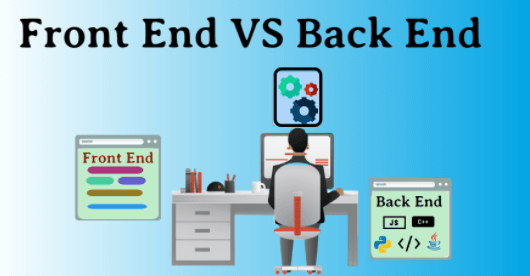Traditionally, companies in the CIS simply do not distinguish between such areas as Front End and Back End development. More precisely, a specialist must be well versed in both industries and perform functionality both for the browser side and software solutions for the server-side.
Based on the practice of European companies, these specializations must be separated and assigned appropriate specialists to perform the assigned tasks. Today back end development services are very popular and needed almost everywhere.
The division of these areas can be roughly compared to the stage and backstage of one theater. The visible part belongs to the Front End components, and the hidden part is the responsibility of the Back End development.
What does Front End development mean?
Despite the divisions, specialists in both specializations are required to be well versed in all related areas that accompany the workflow of developing software products and online resources.
Front End specialist sets tasks for designers, programmers, analysts and marketers. Ultimately, the task of the developer is to create a high-quality appearance that meets all modern design trends and provide the most comfortable interface.
It is not difficult to visually understand the peculiarity of Front End development. It is enough to open any site and go to the browser code. The page code defines the color, functionality, layout, and functions of the user interface components. Fragments of Front End development include:
- HTML. A frame for constructing site pages, which includes program code, extensions, and settings for resource components.
- CSS style sheet. A language for designing individual, typical, and repeating site objects. With the help of a style sheet, the developer controls all the properties of objects and can assign characteristics to an individual element or group of fragments.
- JavaScript. This is an extension to improve the dynamics of static pages of the site. Scrolls, dynamic fragments and special effects work thanks to the JavaScript library.
Front End development and its components provided the look and feel of modern online resources. Thanks to this, we can use the sites every day and satisfy everyday requests with the help of a quality service.
What does back end development mean?
The Back End development competence includes all the software tools that organize the operation of the site on the server side. In other words, these are development components that are hidden from the user’s eyes and take place outside the browser and device zone.
Technically, when a user enters a query into a search engine and clicks search, the Front End area of responsibility comes to a logical conclusion and the Back End competency begins.
The search query goes to the server of the search engine, where data search algorithms are activated. After switching to the required resource, the competence of the Front End components is returned again.
Depending on the set business task, the functions of the back end of the developer vary greatly. By definition, Back End specialist works with programming languages to build effective interaction between the client and the server.
One skilled in the art can use any suitable tool for integrating the program code. Also, for Back End development, you need to be proficient in database management software products: MySQL, SQLite, PostgreSQL.





![1000 Girl Attitude Names for Truecaller ID | UPDATED [Included Boys Names] 1000 Attitude Names for Girls on Truecaller](https://edutechbuddy.com/wp-content/uploads/2025/05/ChatGPT-Image-May-21-2025-11_59_39-PM-1-150x150.png)








![1000 Girl Attitude Names for Truecaller ID | UPDATED [Included Boys Names] 11 1000 Attitude Names for Girls on Truecaller](https://edutechbuddy.com/wp-content/uploads/2025/05/ChatGPT-Image-May-21-2025-11_59_39-PM-1.png)